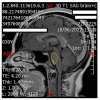Morphological Changes of the Pituitary Gland in Patients with Irritable Bowel Syndrome Using Magnetic Resonance Imaging
- PMID: 39330446
- PMCID: PMC11433444
- DOI: 10.3390/jimaging10090226
Morphological Changes of the Pituitary Gland in Patients with Irritable Bowel Syndrome Using Magnetic Resonance Imaging
Abstract
Irritable bowel syndrome (IBS) is a gastrointestinal functional disorder characterized by unclear underlying mechanisms. Several theories propose that hyperactivation of the hypothalamic-pituitary-adrenal (HPA) axis leads to elevated cortisol levels and increased sensitivity of gut wall receptors. Given the absence of prior literature on this topic, our study aimed to investigate the potential for diagnosing IBS based on morphological changes in the pituitary gland, specifically its volume and grayscale intensity. Additionally, we aimed to assess whether factors such as gender, age, and body mass index influence these parameters. This retrospective study involved 60 patients, examining the volume and grayscale characteristics of their pituitary glands in the presence of IBS. Our findings revealed a positive correlation between pituitary gland volume and IBS diagnosis, although no significant correlation was observed with grayscale intensity. Due to the limited existing research and the small sample size of our study, further investigation with a larger cohort is warranted to validate these results.
Keywords: diagnosis; gastrointestinal tract; irritable bowel syndrome; pituitary; volume calculation.
Conflict of interest statement
The authors declare no conflicts of interest. The funders of the APC had no role in the design of the study; in the collection, analyses, or interpretation of data; in the writing of the manuscript; or in the decision to publish the results.
Figures





References
-
- Arasteh P., Maharlouei N., Eghbali S.S., Amini M., Lankarani K.B., Malekzadeh R. A Comprehensive Look at Irritable Bowel Syndrome and its Associated Factors Considering the Rome IV Criteria: A Penalized Smoothly Clipped Absolute Deviation Regression Approach in the Pars Cohort Study. Middle East J. Dig. Dis. 2018;10:149–159. doi: 10.15171/mejdd.2018.104. - DOI - PMC - PubMed
LinkOut - more resources
Full Text Sources

